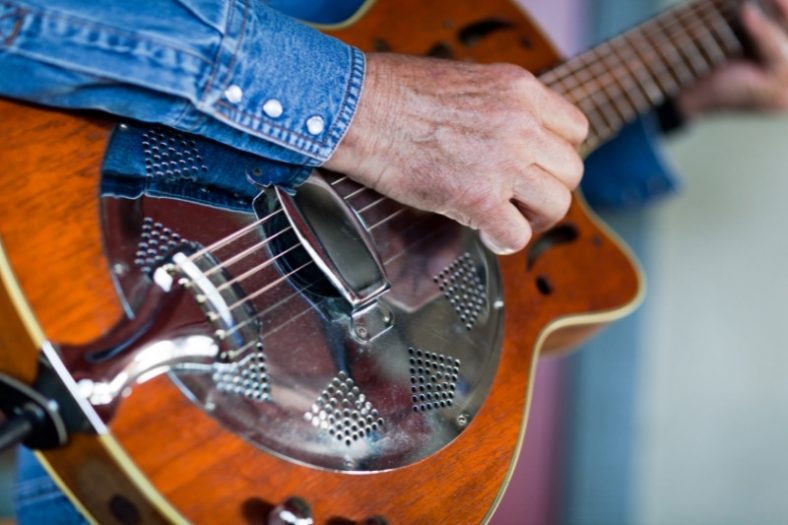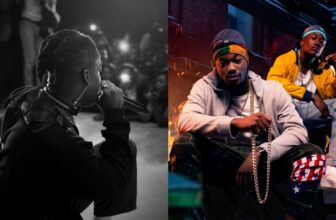20 Types of Blues Music You Should Know About

Blues music originated in the Southern states of the United States of America in the mid-1800s. It was derived from hymns, chants, field hollers, and work songs of formerly enslaved African-Americans.
The genre is identifiable by its use of certain notes, scales, and chord progressions. The 12-bar blues structure is perhaps the most commonly used progression used even today. Many genres such as rock and roll, country, and bluegrass music originate from the blues.
The blues have given birth to not just many new genres of music, but today there are many subgenres of the music as well. Let us take a look at some of the most prominent types of blues music:
Contents
- Origin and Structure of Blues Music:
- 1. Delta Blues
- 2. Chicago Blues
- 3. Contemporary Blues
- 4. Boogie-Woogie
- 5. African Blues
- 6. Classic Female Blues
- 7. Country Blues
- 8. Gospel Blues
- 9. Jump Blues
- 10. Texas Blues
- 11. New Orleans Blues
- 12. Rhythm and Blues
- 13. Piedmont Blues
- 14. Swamp Blues
- 15. Hokum Blues
- 16. British Blues
- 17. Blues Rock
- 18. Soul Blues
- 19. Electric Blues
- 20. Classic Blues
- Conclusion
Origin and Structure of Blues Music:
Very commonly found in blues, country, and even rock music, the blues scale consists of six notes and can be either major or minor. The major blues scale has the notes 1, 2, ♭3, 3, 5, and 6 whereas the minor scale consists of notes 1,♭3, 4, ♭5, 5, and♭7 of a particular key. The addition of a chromatic note to the pentatonic scale gives the music its defining blues sound.
While there is no exact date of origin, most music historians agree that the blues started in the USA in the 1860s after the Civil War, from African-American work songs. The earliest blues songs were sung and the acoustic guitar was added later on. Over the decades, the blues spread to different parts of the country and evolved into many new subgenres.
The name of the genre comes from the feeling of melancholy and sadness that is expressed through the music. Together, blues and jazz are considered the basis of modern music.
1. Delta Blues
This is one of the oldest types of blues music that developed in the Mississippi Delta, from which it gets its name. It is characterized by the use of instruments such as slide guitar and harmonica. The performances were solo and Charley Patton is often regarded as the “Father of the delta blues”.
While delta blues developed many decades before, the first recordings of it can be traced back to the 1920s and Freddie Spruell’s ‘Milk Cow Blues’ is one of the earliest examples.
As musicians migrated, delta blues inspired many different types of blues such as Chicago Blues and even British Blues.
Robert Johnson, Geeshie Wiley, James Cotton, Son House, and Bukka White are considered some of the pioneers of delta blues.
2. Chicago Blues
During the early 20th century, the Great Migration resulted in a shift in not just geography but also musical traditions. Musicians such as Muddy Waters moved to Chicago and a new style developed which featured electronic instruments such as the electric guitar.
It is widely believed that Chicago blues was a precursor to rock and roll since it heavily used distortion effects such as overdrive. Early Chicago blues consisted of the electric guitar, harmonica, drums, and double bass before shifting to electric basses. The performer would either sing with a band or with a piano, depending on their style.
Chicago Blues inspired not just rock and roll but also ‘urban blues’, and some prominent exponents of Chicago Blues were Muddy Waters, Howlin Wolf, Buddy Guy, Eddie King, and John Lee Hooker.
3. Contemporary Blues
While the blues started in the 19th century, it has undergone many changes. Contemporary blues is also known as ‘modern blues’ music. While it draws inspiration from acoustic and electric blues, it also incorporates more modern elements such as slick production and pop songwriting elements.
Contemporary blues may lack the aggression of Texas blues, but the smoothness of the genre makes it appeal to a larger, more mainstream audience. It is often a mix of blues and rock with soul music.
Susan Tedeschi, Jonny Lang, Joe Bonamassa, Gary Clarke Jr., and The Derek Trucks Band are some artists who are considered contemporary blues musicians.
4. Boogie-Woogie
We tend to associate blues music with themes of sadness and strife, but Boogie-Woogie is just one of the examples of how incredibly diverse the genre is. As Big Band music started to gain traction, Boogie-Woogie emerged in the 1920s and remained popular till the 1950s.
This genre emphasizes intricate rhythms played on the piano, accompanied by vocals. While piano has been a prominent instrument in blues music, in Boogie-Woogie, one plays a syncopated and repetitive rhythm on eighth notes with their left hand and a melody with the right. The emphasis is on a groove more than a tune.
Here is an example of this style of piano playing.
Some of the biggest names of the subgenre include but are not limited to Pinetop Smith, Jimmy Blythe, and Fats Domino.
5. African Blues
Since many people were forcefully brought to the United States from West African countries and made to work at plantations, they carried their musical traditions with them. Many music historians believe that while the blues is an American genre, it has roots in African music.
Another group of scholars believe that certain aspects of the music such as the call and response in work songs, and field hollers are linked to the musical traditions of West Africa. Blues music that found its way back to Africa from the USA and is often also referred to as ‘African blues’.
The Malian musician Ali Farka Touré was perhaps the most influential figure in African blues. Some other prominent African Blues musicians are Baaba Maal, Boubacar Traoré, and Rokia Traore.
6. Classic Female Blues
The contribution of women musicians in the history of blues music is often overlooked. In 1920, many prominent blues musicians were female and had an enormous impact on the growth and evolution of the genre. This period is often referred to as the ‘classic female blues’ era.
While many argue that gender alone cannot be a determining factor for a subgenre, the reason we call this era ‘classic female blues’ is that some of these musicians were the first African-American women to record their music and it is through these recordings that 12-bar blues spread to the other parts of the country.
Ma Rainey, Bessie Smith, Victoria Spivey, Ida Cox, and Mamie Smith are considered musicians of the Classic Female Blues period.
7. Country Blues
We know that country music evolved from blues. Country blues originated in the 1920s and is considered one of the earliest forms of blues music. It is defined by the simple arrangement with an accompanying acoustic guitar and deeply emotive vocals.
While delta blues refers to the music of the Mississippi delta, country blues includes various regional blues such as Piedmont, Georgia, and even Texas. Rather than the area it came from, the focus is on the style of music. Country blues is performed solo, the structure follows either a 12 or a 16-bar blues cycle, and the instruments used are acoustic.
The music of Mississippi John Hurt, Furry Lewis, Gary Davis, and Willie Dixon is considered Country Blues.
8. Gospel Blues
Although the early forms of blues were secular, religious music has always played an important part in the foundation of blues. Also known as ‘Holy Blues’, gospel blues combines blues standards with evangelical lyrical themes.
Some gospel blues musicians such as Reverend Robert Wilkins were members of the clergy whereas others like Blind Lemon Jefferson and Bukka White recorded songs in this genre.
Sister Rosetta Tharpe and Reverend Gary Davis played gospel blues and the term ‘holy blues’ was coined to describe the latter’s style of music.
9. Jump Blues
Jump blues emerged from Big Band music of the 1940s. It is uptempo and often incorporates horn instruments such as the saxophone. Unlike Big Band music, it is played in small groups and along with Boogie-Woogie, jump blues is considered the foundation of rock and roll.
Jump groups such as the Tympany Five combined elements of jazz and blues with distorted electric guitars and this new sound quickly became very popular. Their recording of ‘Saturday Night Fish Fry’ is considered one of the earliest examples of Jump Blues.
In the 1990s, there was a renewed interest in jump blues as swing music made a brief comeback.
T-Bone Walker, Louis Jordan, Roy Milton, and Big Joe Turner played what is considered Jump Blues.
10. Texas Blues
Just like Chicago blues, many blues musicians migrated to Texas cities such as Houston, Galveston, San Antonio, and Dallas later, during the Great Depression.
While early Texas blues (the 1920s) had strong swing and jazz influences, in the 1960s and 1970s elements from blues rock and country music influenced the genre. Today, we associate it with electric guitar solos, accompanied by instruments such as horns, keyboard, and drums.
Albert Collins, Johnny Copeland, Eric Johnson, Big Mama Thornton, and Stevie Ray Vaughan are Texas blues musicians.
11. New Orleans Blues
Another regional variation of blues music came from New Orleans. This was a combination of blues, Caribbean music, and jazz. Although guitars feature in this genre, it is predominantly known for the use of horns such as the saxophone and piano.
Professor Longhair is arguably the most well-known name in New Orleans blues and his contemporaries include James Booker and Guitar Slim.
Since New Orleans was known for its jazz, New Orleans blues was relatively less popular. As rock and roll enjoyed success in the 1960s, the interest in New Orleans blues declined. The 1970s saw a resurgence of the genre again.
12. Rhythm and Blues
Rhythm and blues, one of the most popular genres of music today emerged from the blues. In his book ‘Deep Blues’, Robert Palmer states that the term ‘rhythm and blues’ was invented by record companies who wanted to market this new music to African-American listeners in the 1940s.
It was “an urbane, rocking, jazz-based music with a heavy, insistent beat.” by Robert Palmer.
Rhythm and blues has undergone many transformations over the different decades. In the 1950s, the term was used to describe blues records, whereas in the 70s soul and funk music was considered ‘rhythm and blues’. Today, it is a mix of pop, hip-hop, soul, disco, and even electronica.
Beyoncé, Ariana Grande, H.E.R, and The Weeknd are some of the most popular names in rhythm and blues today.
13. Piedmont Blues
Piedmont blues originated from the Eastern Coast of the USA and is distinctly different from Delta, Texas, and Chicago blues. Ragtime is an integral part of this genre and it features fingerpicking guitar techniques.
It originated in the 1920s and was popular till the 1940s in places such as West Virginia, Delaware, Alabama, and Richmond.
The recordings of artists such as Buddy Moss, Blind Boy Fuller, Brownie McGhee, and Blind Blake are some examples of Piedmont blues.
14. Swamp Blues
While jazz was a defining factor of New Orleans blues, swamp blues drew its inspiration from Cajun and Zydeco music. The genre features simple guitars in a slow and laid-back tempo, with shuffle grooves. Other characteristics of this sound include the use of harmonica and tremolo guitars with minimal percussive elements.
Together, swamp blues and New Orleans blues are known as ‘Louisiana blues’.
Slim Harper, Lazy Lester, and Katie Webster are a few names that have been known to play the swamp blues.
15. Hokum Blues
We may be familiar with metaphors and euphemisms in modern music, but the origin of the style can be traced back to ‘Hokum’ in the early blues.
Some of the main themes of Hokum blues encompass race, gender, sexuality, and alcohol. The early practitioners of this form such as the Memphis Jug Band used conventional instruments such as the harmonica and banjo with more unconventional ones like spoons and even washboards.
Hokum blues is identifiable by the use of lyrical imagery, comedy, and upbeat melodies. Some examples of this genre are ‘Banana In Your Fruit Basket’ by Bo Carter and ‘My Stove’s in Good Condition’ by Lil Johnson.
16. British Blues
Blues may have originated in the United States of America but by the late 1950s, it gained immense popularity in the United Kingdom as well. Just like Chicago and Texas, British blues drew from local influences while still maintaining the ethos of Classic Blues music. The electric guitar was a prominent aspect of it and bands such as The Rolling Stones and Led Zeppelin helped introduce it to a more mainstream audience.
It is widely believed that blues reached Britain via the American soldiers who were stationed there during the Second World War. They were responsible for introducing the country to artists such as Fats Waller and Ma Rainey.
Some exponents of British blues are Eric Clapton and Fleetwood Mac.
17. Blues Rock
Since rock and roll came from the blues, it was a natural progression for the two to combine. Blues-rock is a mix of electric blues with Southern and even hard rock music. It emerged in the 1960s in both the United Kingdom as well as the United States of America.
Blues-rock features extensive improvisation and fixed riffs often played over a 12 or a 16-bar blues structure. Instruments such as drums, electric bass, keyboard, and electric guitar are used to create a heavy and amplified sound.
While bands such as Canned Heat, the Yardbirds, and the Animals are some of the early examples of this genre, it thrives even today among bands such as the Black Keys and the White Stripes.
18. Soul Blues
Soul blues originated in the 1960s. Many musicians believed that the convention of using standard three-chord progressions in blues was too restrictive and wanted to break free from the conventions.
They combined traditional blues instruments with the rhythm and melody of soul music. Most scholars believe that one of the founders of this genre was Bobby Bland.
Ray Charles and Otis Redding are musicians who played this genre.
19. Electric Blues
Broadly, any blues that is played with electric instruments can be considered Electric blues. But it is important to remember that the blues was originally associated with acoustic instruments such as the harmonica, vocals, and acoustic guitar.
In the 1930s, with the availability of amplification and electric guitars, musicians such as T-Bone Walker, Sister Rosetta Tharpe, and Muddy Waters used the guitar in innovative new ways by incorporating sound effects such as overdrive. This not only gave birth to a new era in blues music but also paved the way for genres such as rock and roll.
John Lee Hooker, B.B. King, and Booker T. & The MG’s played electric blues.
20. Classic Blues
Today, since there are so many new sub-genres in blues music, Classic blues refers to the earliest recordings of the genre that were made in the 1920s and 30s since there are no known recordings before that. Many blues songs were passed down through oral tradition before recording technology was available.
Classic blues is identifiable by its repetitive lyrics, acoustic instrumentation, and 12-bar chord structures. These songs were a narrative of African-American life and themes often revolved around oppression and melancholy.
Sub-genres such as Delta and Pre-War Blues are considered to be a part of Classic Blues. Some of the most influential Classic Blues musicians are Robert Johnson, Bessie Smith, Son House, and Lead Belly.
Conclusion
Since blues is one of the oldest genres of modern music, it has undergone many transformations over the decades. While it originated in the plantations as field hollers, today it is celebrated across the world and there are many festivals dedicated to it.
Whether you’re a fan of the delta blues or you enjoy blues rock, there is something for everybody. Despite the tragic circumstances it was born under, without the blues modern music would never sound the same!





